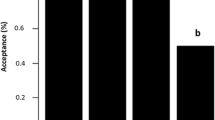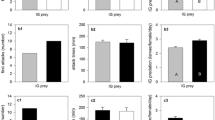Abstract
We tested whether specialist and generalist phytoseiid mites differ in aggressiveness and prey choice in cannibalism and intraguild predation. Specialists tested were Galendromus occidentalis, Neoseiulus longispinosus, Phytoseiulus persimilis, and P. macropilis; tested were Amblyseius andersoni, Euseius finlandicus, E. hibisci, Kampimodromus aberrans, Neoseiulus barkeri, N. californicus, N. cucumeris, N. fallacis, and Typhlodromus pyri. Aggressiveness of cannibalistic females against larvae was not related to diet specialization except that highly aggressive species were exclusively generalists. Seldom to moderately cannibalizing species occurred in both generalist and specialist phytoseiids. In contrast to aggressiveness in cannibalism, generalists and specialists differed in aggressiveness in intraguild predation. Adult females of specialists were only slightly aggressive against heterospecific larvae, whereas adult females of all generalists except T. pyri were highly aggressive. Adult females of generalists were able to discriminate between con- and heterospecific larvae and preferentially consumed the latter when given a choice. Adult females of specialists except G. occidentalis showed no preference when given a choice between con- and heterospecific larvae. We conclude that aggressiveness in intraguild predation, species recognition and subsequent preferential consumption of heterospecifics when given a choice is common in generalist but not specialist phytoseiids. We discuss the evolutionary pathways that might have led to the difference between specialists and generalists in species discrimination.
Similar content being viewed by others
References
Armitage, P. and Colton, T. 1998. Encyclopedia of Biostatistics.Wiley, Chichester, England.
Arn, H. 1991. Sex pheromones. In: Tortricid pests, their biology, natural enemies and control, L.P.S van der Geest and H.H. Evenhuis (eds), pp. 187–207. Elsevier, Amsterdam.
Croft, B.A. and Croft M.B. 1996. Intra-and interspecific predation among adult female phytoseiid mites (Acari: Phytoseiidae): effects on survival and reproduction. Environ. Entomol. 25: 853–858.
Croft, B.A., Kim, S.S. and Kim, D.I. 1995. Leaf residency and interleaf movement of four phytoseiid mites (Acari: Phytoseiidae) on apple. Environ. Entomol. 24: 1344–1351.
Croft, B.A., Kim, S.S. and Kim, D.I. 1996. Intra-and interspecific predation by Metaseiulus occidentalis, Typhlodromus pyri, Neoseiulus fallacis and Amblyseius andersoni on different life stages: effects on survival, oviposition and activity. Exp. Appl. Acarol. 20: 435–444.
Croft, B.A., Monetti, L.N. and Pratt, P.D. 1998. Comparative life histories and predation types: are Neoseiulus californicus and N. fallacis (Acari: Phytoseiidae) similar type II selective predators of spider mites. Environ. Entomol. 27: 531–538.
Croft, B.A., Luh, H.K. and Schausberger, P. 1999. Larval size relative to larval feeding, cannibalism on larvae, egg size or adult female size and larval-adult setae patterns among 13 phytoseiid mite species. Exp. Appl Acarol. 23: 599–610.
Dall, S.R.X. and Cuthill, I.C. 1997. The information costs of generalism. Oikos 80: 197–202.
Dicke, M., Takabayashi, J., Posthumus, M.A., Schuette, C. and Krips, O. 1998. Plantphytoseiid interactions mediated by herbivore-induced plant volatiles: variation in production of cues and in responses of predatory mites. Exp. Appl. Acarol. 22: 311–333.
Elgar, M.A. and Crespi, B.J. (eds) 1992. Cannibalism: Ecology and Evolution among Diverse Taxa. Oxford University Press, Oxford, UK.
Faraji, F., Janssen, A., van Rijn P.C.J. and Sabelis, M.W. 2000. Kin recognition by the predatory mite Iphiseius degenerans: discrimination among own, conspecific, and heterospecific eggs. Ecol. Entomol. 25: 147–155.
Fox, L.R. 1975. Cannibalism in natural populations. Ann. Rev. Ecol. Syst. 6: 87–106.
Helle,W. and Sabelis,M.W. 1985. Spider Mites, Their Biology, Natural Enemies and Control, Vol 1B. Elsevier, Amsterdam.
Hislop, R.G. and Prokopy, R.J. 1981. Mite predator responses to prey and predator-emitted stimuli. J. Chem. Ecol. 7: 895–904.
MacRae, I.V. and Croft, B.A. 1993. Influence of temperature on interspecific predation and cannibalism by Metaseiulus occidentalis and Typhlodromus pyri (Acarina: Phytoseiidae). Environ. Entomol. 22: 770–775.
McMurtry, J.A. and Croft, B.A. 1997. Life-styles of phytoseiid mites and their roles in biological control. Ann. Rev. Entomol. 42: 291–321.
McMurtry, J.A. and Rodriguez, J.G. 1987. Nutritional ecology of phytoseiid mites. In: Nutritional ecology of insects, mites and spiders, F. Slansky and J.G. Rodriguez (eds), pp. 609–644. Wiley, New York.
McMurtry, J.A. and Scriven, G.T. 1965. Insectary production of phytoseiid mites. J. Econ. Entomol. 58: 282–284.
Monetti, L.N. and Croft, B.A. 1997. Mating, cross-mating and related behaviours of Neoseiulus californicus and Neoseiulus fallacis (Acari: Phytoseiidae). Exp. Appl. Acarol. 21: 67–74.
Palevsky, E. 1997. Development of a program for integrated management of the European red mite, Panonychus ulmi, for the main apple cultivars in Israel. PhD Dissertation, Hebrew University of Jerusalem, Israel.
Polis, G.A. 1981. The evolution and dynamics of intraspecific predation. Ann. Rev. Ecol. Syst. 12: 225–251.
Polis, G.A., Myers, C.A. and Holt, R.D. 1989. The ecology and evolution of intraguild predation: potential competitors that eat each other. Ann. Rev. Ecol. Syst. 20: 297–330.
Rosenheim, J.A., Kaya, H.K., Ehler, L.E., Marois, J.J. and Jaffee, B.A. 1995. Intraguild predation among biological control agents: theory and evidence. Biol. Control 5: 303–335.
Sabelis, M.W. 1985a. Reproduction. In: Spider mites, their biology, natural enemies and control, Vol 1B, W. Helle and M.W. Sabelis (eds), pp. 73–82. Elsevier, Amsterdam.
Sabelis, M.W. 1985b. Predation on spider mites. In: Spider mites, their biology, natural enemies and control, Vol 1B, W. Helle and M.W. Sabelis (eds), pp. 103–130. Elsevier, Amsterdam.
Sabelis, M.W. and Bakker, F. 1992. How predatory mites cope with the web of their tetranychid prey: a functional view of the dorsal chaetotaxy in the Phytoseiidae. Exp. Appl. Acarol. 16: 203–225.
Sabelis, M.W. and Dicke, M. 1985. Long range dispersal and searching behaviour. In: Spider mites, their biology, natural enemies and control, Vol 1B,W. Helle and M.W. Sabelis (eds), pp. 141–160. Elsevier, Amsterdam.
Sabelis, M.W. and Janssen, A. 1994. Evolution of life-history patterns in the Phytoseiidae. In: Mites: ecological and evolutionary analyses of life history patterns, M.A. Houck (ed.), pp. 70–98. Chapman and Hall, London, UK.
Schausberger, P. 1997. Inter-and intraspecific predation on immatures by adult females in Euseius finlandicus, Typhlodromus pyri and Kampimodromus aberrans (Acari: Phytoseiidae). Exp. Appl. Acarol. 21: 131–150.
Schausberger, P. 1999a. Juvenile survival and development in Euseius finlandicus, Typhlodromus pyri and Kampimodromus aberrans (Acari, Phytoseiidae) feeding on con-and heterospecific immatures. Exp. Appl. Acarol. 23: 297–307.
Schausberger, P. 1999b. Predation preference of Typhlodromus pyri and Kampimodromus aberrans (Acari, Phytoseiidae) when offered con-and heterospecific immature life stages. Exp. Appl. Acarol. 23: 389–398.
Schausberger, P. and Croft, B.A. 1999a. Predation on and discrimination between conand heterospecific eggs among specialist and generalist phytoseiid mite species (Acari: Phytoseiidae). Environ. Entomol. 28: 523–528.
Schausberger, P. and Croft, B.A. 1999b. Activity, feeding, and development among larvae of specialist and generalist phytoseiid mite species (Acari: Phytoseiidae). Environ. Entomol. 28: 322–329.
Schausberger, P. and Croft, B.A. 2000. Nutritional benefits of intraguild predation and cannibalism among generalist and specialist phytoseiid mites. Ecol. Entomol. (in press). SPSS 1997. Advanced Statistics 7.5. SPSS Inc., Chicago, USA.
Walzer, A. and Schausberger, P. 1999a. Cannibalism and interspecific predation in the phytoseiid mites Phytoseiulus persimilis and Neoseiulus californicus: predation rates and effects on reproduction and juvenile development. BioControl 43: 457–468.
Walzer, A. and Schausberger, P. 1999b. Predation preferences and discrimination between conand heterospecific prey by the phytoseiid mites Phytoseiulus persimilis and Neoseiulus californicus. BioControl 43: 469–478.
Yao, D.S. and Chant, D.A. 1989. Population growth and predation interference between twospecies of predatory phytoseiid mites (Acarina: Phytoseiiidae) in interactive systems. Oecologia 80: 443–455.
Zhang, Z.Q. and Croft, B.A. 1995a. Intraspecific competition in immature Amblyseius fallacis, Amblyseius andersoni, Typhlodromus occidentalis and Typhlodromus pyri (Acari: Phytoseiidae). Exp. Appl. Acarol. 19: 65–77.
Zhang, Z.Q. and Croft, B.A. 1995b. Interspecific competition and predation between immature Amblyseius fallacis, Amblyseius andersoni, Typhlodromus occidentalis and Typhlodromus pyri (Acari: Phytoseiidae). Exp. Appl. Acarol. 19: 247–257.
Zhang, Z.Q. and Sanderson, J.P. 1997. Patterns, mechanisms and spatial scale of aggregation in generalist and specialist predatory mites (Acari: Phytoseiidae). Exp. Appl. Acarol. 21: 393–404.
Author information
Authors and Affiliations
Rights and permissions
About this article
Cite this article
Schausberger, P., Croft, B.A. Cannibalism and Intraguild Predation Among Phytoseiid Mites: Are Aggressiveness and Prey Preference Related to Diet Specialization?. Exp Appl Acarol 24, 709–725 (2000). https://doi.org/10.1023/A:1010747208519
Issue Date:
DOI: https://doi.org/10.1023/A:1010747208519




